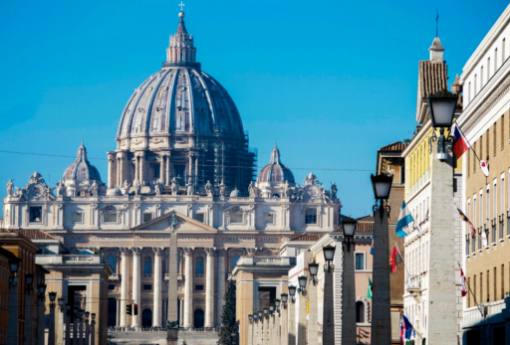The Dome of St. Peter's, an iconic symbol of Vatican City, holds a significant place in the world of architecture and religious symbolism. With its intricate design, rich history, and ongoing restoration efforts, the Dome of St. Peter's serves as a testament to the skill and dedication of those who have contributed to its construction and preservation. Its influence on architectural styles and religious practices is undeniable, making it a must-see attraction for visitors to Vatican City.

Architectural Features of the Dome of St. Peter's
The Dome of St. Peter's is one of the most iconic architectural features of the Vatican City. It is the tallest dome in the world, standing at 57 meters high and 47 meters in diameter. The dome was designed by Michelangelo and Giacomo della Porta, and it is a masterpiece of Renaissance architecture.
The dome is supported by four large piers, each containing a spiral staircase that leads to the top of the dome. The exterior of the dome is made of bricks and covered with lead sheets, giving it a striking gray color. The interior of the dome is decorated with intricate mosaics and features a central oculus that lets in natural light.
The dome is topped with a lantern that serves as a beacon for the faithful. It is decorated with statues of saints and angels, adding to the grandeur of the structure. The dome is a marvel of engineering, with its innovative double shell construction that provides strength and stability.
Overall, the architectural features of the Dome of St. Peter's are a testament to the skill and creativity of the Renaissance architects who designed it. It is a symbol of beauty and grandeur that continues to awe visitors from around the world.
Symbolism and Religious Significance of the Dome of St. Peter's
The Dome of St. Peter's holds immense symbolism and religious significance for Catholics around the world. The dome represents the heavens and the connection between heaven and earth. It serves as a visual reminder of the presence of God and his protection over the church and its followers. The height and grandeur of the dome reflect the majesty and power of God.
In addition to its symbolic significance, the dome of St. Peter's also holds religious importance for Catholics. It is the final resting place of the apostle St. Peter, considered the first pope by the Catholic Church. The dome acts as a symbol of the authority and primacy of the papacy, as well as a focal point for the religious devotion of Catholics.
Furthermore, the dome of St. Peter's is decorated with intricate mosaics and artwork that depict scenes from the Bible and the lives of saints. These artistic elements serve to inspire and uplift worshippers, as well as to educate them on the teachings of the Catholic faith.
Overall, the Dome of St. Peter's is a powerful symbol of faith and devotion for Catholics, serving as a physical representation of their beliefs and the presence of God in their lives.
Restoration Efforts on the Dome of St. Peter's
Restoration Efforts on the Dome of St. Peter's
The Dome of St. Peter's, located in Vatican City, is one of the most iconic architectural structures in the world. Over the centuries, the dome has undergone several restoration efforts to ensure its preservation and structural integrity. One of the most significant restoration projects took place in the late 20th century, led by a team of dedicated experts and artisans.
The restoration efforts on the dome focused on repairing damage caused by weathering, pollution, and aging. The exterior of the dome was carefully cleaned and repaired, with special attention paid to the intricate details of the architectural design. Artisans used traditional techniques to restore the original splendor of the dome, ensuring that it would continue to stand as a testament to the ingenuity and craftsmanship of its creators.
In addition to the physical repairs, the restoration efforts also included the installation of modern technology to monitor the dome's structural health and stability. This technology allows experts to track any changes in the dome's condition and address potential issues before they become major problems.
Overall, the restoration efforts on the Dome of St. Peter's have been essential in preserving this architectural masterpiece for future generations to admire and appreciate. The dedication and skill of the restoration team have ensured that the dome will continue to inspire awe and wonder in all who behold it.
Influence of the Dome of St. Peter's on Architecture
The Dome of St. Peter's has had a profound influence on architecture throughout history. Its grandeur and innovative design have inspired countless architects and designers to push the boundaries of what is possible in architectural construction. The dome's perfect proportions and structural integrity have served as a model for many other domed structures around the world. Its design principles have been studied and emulated by architects seeking to create iconic and awe-inspiring buildings. The Dome of St. Peter's has set a standard for beauty, symmetry, and grandeur in architecture, and its influence can be seen in many of the world's most famous buildings.
